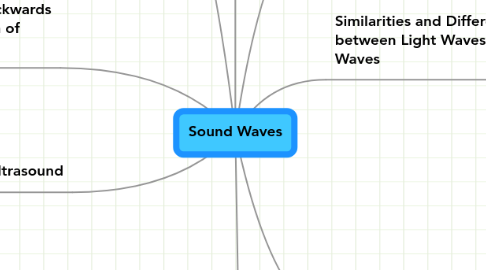
1. Speed of Sound
1.1. In Gases
1.1.1. Air
1.1.1.1. 331 m/s at 0ºC
1.1.1.2. 343 m/s at 20ºC
1.1.2. Oxygen
1.1.2.1. 316 m/s
1.1.3. Helium
1.1.3.1. 965 m/s
1.1.4. Carbon Dioxide
1.1.4.1. 256 m/s
1.2. In Liquids
1.2.1. Pure Water
1.2.1.1. 1482 m/s
1.2.2. Mercury
1.2.2.1. 1450 m/s
1.2.3. Ethanol
1.2.3.1. 1162 m/s
1.2.4. Chloroform
1.2.4.1. 1004 m/s
1.3. In Solids
1.3.1. Steel
1.3.1.1. 5960 m/s
1.3.2. Glass
1.3.2.1. 5640 m/s
1.3.3. Copper
1.3.3.1. 5010 m/s
1.3.4. Lead
1.3.4.1. 1960 m/s
1.4. Speed of Sound in: Solids > Liquids > Gases
1.4.1. Compressions and rarefactions propagate faster in denser media.
1.5. Calculation of Speed of Sound
1.5.1. V = D / T
1.5.2. V = f * λ
1.6. Factors Affecting the Speed of Sound
1.6.1. Wind
1.6.2. Temperature
1.6.3. Humidity
1.6.4. Pressure
1.6.5. Nature of Material
2. Perception and Audibility of Sound
2.1. Pitch
2.1.1. Tone refers to any sound that is perceived.
2.1.2. Pitch refers to the frequency of a given tone.
2.1.3. Pitch is dependent on frequency: the higher the frequency of the sound wave, the higher the pitch.
2.1.4. Cathode ray oscilloscopes are used to show the waveforms of sound waves with different frequencies.
2.2. Loudness
2.2.1. Amplitude refers to the displacement of the wave from the normal, undisturbed position.
2.2.2. Loudness is dependent on amplitude: the greater the amplitude, the louder the sound.
2.3. Audible Frequencies
2.3.1. Range of audible frequencies (see below) decreases as humans age and their ears lose sensitivity to both high and low frequencies.
2.3.2. Humans
2.3.2.1. 20 Hz to 20 000 Hz
2.3.3. Sounds which are above the upper hearing limit are termed as ultrasound.
2.3.4. Sounds below the lower hearing limit are termed as infrasound.
3. Ultrasound
3.1. Ultrasound is a type of sound wave with frequencies above the upper hearing limit, i.e., more than 20 kHz.
3.2. Examples of Ultrasound Use
3.2.1. Diagnostic Sonography
3.2.1.1. Visualising body structures beneath the skin, including tendons, muscles, joints, vessels and internal organs for possible pathology or lesions. Diagnostic sonography is widely used in obstetrics to determine the biological characteristics of a fetus.
3.2.2. Ultrasound Testing
3.2.2.1. Very short ultrasonic pulse-waves are launched into materials to detect internal flaws or to characterize materials.
4. Sound is energy propagated in the form of longitudinal waves in which particles of the medium vibrate backwards and forwards in a direction parallel to the direction of propagation of the wave itself.
5. Propagation of Sound
5.1. Motion
5.1.1. Compression
5.1.1.1. Compressions are regions in the medium where the particles are close together.
5.1.1.2. Compressions are regions where the air has a slightly increased pressure as a result of the particles being closer together.
5.1.2. Rarefaction
5.1.2.1. Rarefactions are regions in the medium where the particles are far apart.
5.1.2.2. Rarefactions are regions where the air has a slightly decreased pressure as a result of the particles being further apart.
5.1.3. The wavelength for longitudinal waves is the distance between adjacent regions where the particles that are moving are in phase.
5.2. Production
5.2.1. Sound waves are produced when a vibrating object causes small but rapid changes to the air pressure around it.
5.2.2. Layers of air are pushed together and the air particles are compressed.
5.2.3. Layers of air are pulled apart and the air particles are rarefied.
5.3. Waveforms
5.3.1. The waveform of sound shows how the air pressure changes. The crests of the wave correspond to the compressions of the sound and the troughs correspond to rarefactions.
6. Transmission of Sound
6.1. Medium
6.1.1. Sound waves need a medium for transmission.
6.1.2. Materials which can be compressed and rarefied (stretched) can carry sound waves.
6.1.3. Media
6.1.3.1. Sound cannot propagate through a vacuum.
6.1.3.2. Sound can propagate through gases, liquids and solids.
6.2. Factors
6.2.1. 1.) Differences in the strength of the inter-atomic forces.
6.2.2. 2.) Proximity of atoms to each other in the three states.
6.3. Sound travels at different speeds in gases, liquids and solids.
7. Reflection of Sound
7.1. Echo
7.1.1. Sound waves can be reflected by large, hard surfaces.
7.1.2. If the reflected sound is heard as a separate sound after an interval of silence.
7.2. Reverberation
7.2.1. If the reflected sound is cannot be distinguished with the original sound – the original sound seems prolonged.
8. Similarities and Differences between Light Waves and Sound Waves
8.1. Similarities
8.1.1. Both sound and light waves reflect and refract (as well as diffract and interfere).
8.1.2. Both sound and light waves are wave motions and therefore have all the properties of a wave.
8.1.3. Both sound and light waves are forms of energy propagating through media.
8.2. Differences
8.2.1. Sound waves are mechanical, longitudinal waves, whereas light waves are electromagnetic, transverse waves.
8.2.2. Sound waves require solid, liquid or gaseous media to travel, whereas light waves can travel through vacuum media but will not pass through any material that is opaque.
8.2.3. The denser the medium, the greater the speed of sound waves whereas the denser the medium, the slower the speed of light waves.
